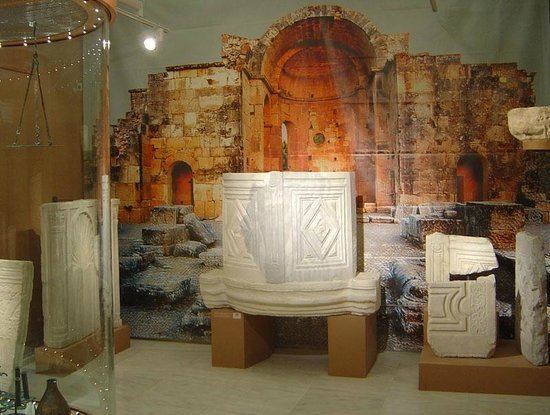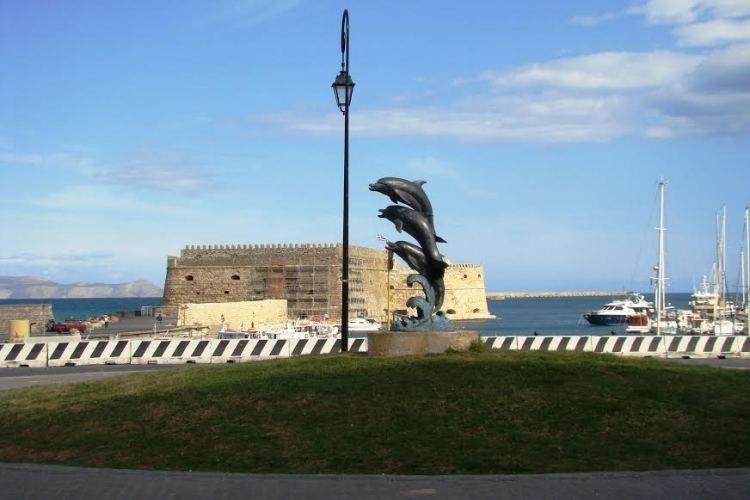Country Mayor Vasilios Labrinos (SYRIZA) | Area 120 km2 Population 135,761 (2001) | |
 | ||
Points of interest Knossos, Heraklion Archaeological Museum, Historical Museum of Crete, Natural History Museum of Crete, Koules Fortress Colleges and Universities University of Crete (Rethymno), Technological Educational Institute of Crete (Heraklion), Foundation for Research & Technology – Hellas (Vassilika Vouton - Heraklion), MBS College of Crete | ||
Map of Heraklion
Heraklion (, Greek: Ηράκλειο, Irákleio, [iˈraklio], Turkish: Kandiye, Italian: Candia) is the largest city and the administrative capital of the island of Crete. It is the fourth largest city in Greece and the third urban area in Greece. According to the results of the 2011 census, the population of the city proper was 140,730 inhabitants, the municipality's was 173,993 while the Heraklion urban area has a population of 225,574 and it extends over an area of 684.3 km2 (264.2 sq mi).
Contents
- Map of Heraklion
- Greececreteheraklion cityold harbour
- Canyon of tripiti in south heraklion crete greece thalori activities
- Names
- History
- Emirate of Crete
- Byzantine era
- Venetian era
- Ottoman era
- Modern era
- Architecture and urban sculpture
- Municipality
- Port
- Airport
- Highway network
- Public transit
- Railway
- Climate
- Colleges universities libraries and research centers
- Museums
- Sports
- Famous natives
- Literature
- Scientists and scholars
- Painting and sculpture
- Film industry
- Music
- Business
- Politics
- Law
- Clergy
- Fashion
- Local TV stations
- Local transport services
- Twin towns and sister cities
- Grecotel amirandes luxury resort mediterranean international cuisine in heraklion crete
- References

Heraklion is the capital of Heraklion regional unit.

The Bronze Age palace of Knossos, also known as the Palace of Minos, is located nearby.
Greece,crete,heraklion city&old harbour
Canyon of tripiti in south heraklion crete greece thalori activities
Names
The Arab raiders from Andalusia (Iberia) who founded the Emirate of Crete moved the island's capital from Gortyna to a new castle they called rabḍ al-ḫandaq (Arabic: ربض الخندق) Castle of the Moat in the 820s. This was hellenized as Χάνδαξ (Khándax) or Χάνδακας (Khándakas) and Latinized as Candia, which was taken into other European languages: in Italian and Latin as Candia, in French as Candie, in English as Candy, all of which could refer to the island of Crete as a whole as well as to the city alone; the Ottoman name was Kandiye.
After the Byzantine reconquest, the city was locally known as Megalo Kastro (Μεγάλο Κάστρο, 'Big Castle' in Greek) or Castro and its inhabitants were called Kastrinoi or Castrini ('castle-dwellers' in Greek).
The ancient name Ηράκλειον was revived in the 19th century and comes from the nearby Roman port of Heracleum ("Heracles's city"), whose exact location is unknown. English usage formerly preferred the classicizing transliterations "Heraklion" or "Heraclion", but the form "Iraklion" is becoming more common.
History
Heraklion is close to the ruins of the palace of Knossos, which in Minoan times was the largest centre of population on Crete. Though there is no archaeological evidence of it, Knossos might well have had a port at the site of Heraklion as early as 2000 BC.
Emirate of Crete
The present city of Heraklion was founded in 824 by the Arabs under Abu Hafs Umar who had been expelled from Al-Andalus by Emir Al-Hakam I and had taken over the island from the Eastern Roman Empire. They built a moat around the city for protection, and named the city ربض الخندق, rabḍ al-ḫandaq ("Castle of the Moat"). It became the capital of the Emirate of Crete (ca. 827–961). The Saracens allowed the port to be used as a safe haven for pirates who operated against Imperial (Byzantine) shipping and raided Imperial territory around the Aegean.
Byzantine era
In 961, Byzantine forces under the command of Nikephoros Phokas, later to become Emperor, landed in Crete and attacked the city. After a prolonged siege, the city fell. The Saracen inhabitants were slaughtered, the city looted and burned to the ground. Soon rebuilt, the town was renamed Χάνδαξ, Chandax, and remained under Greek control for the next 243 years.
Venetian era
In 1204, the city was bought by the Republic of Venice as part of a complicated political deal which involved, among other things, the Crusaders of the Fourth Crusade restoring the deposed Eastern Roman Emperor Isaac II Angelus to his throne. The Venetians improved on the ditch of the city by building enormous fortifications, most of which are still in place, including a giant wall, in places up to 40 m thick, with 7 bastions, and a fortress in the harbour. Chandax was renamed Candia and became the seat of the Duke of Candia, and the Venetian administrative district of Crete became known as "regno di Candia" (kingdom of Candia). The city retained the name of Candia for centuries and the same name was often used to refer to the whole island of Crete as well. To secure their rule, Venetians began in 1212 to settle families from Venice on Crete. The coexistence of two different cultures and the stimulus of Italian Renaissance led to a flourishing of letters and the arts in Candia and Crete in general, that is today known as the Cretan Renaissance.
Ottoman era
After the Venetians came the Ottoman Empire. During the Cretan War (1645–1669), the Ottomans besieged the city for 21 years, from 1648 to 1669, perhaps the longest siege in history. In its final phase, which lasted for 22 months, 70,000 Turks, 38,000 Cretans and slaves and 29,088 of the city's Christian defenders perished. The Ottoman army under an Albanian grand vizier, Köprülü Fazıl Ahmed Pasha conquered the city in 1669. Under the Ottomans, the city was known officially as Kandiye (again also applied to the whole island of Crete) but informally in Greek as Megalo Castro (Μεγάλο Κάστρο; "Big Castle"). During the Ottoman period, the harbour silted up, so most shipping shifted to Chania in the west of the island.
Modern era
In 1898, the autonomous Cretan State was created, under Ottoman suzerainty, with Prince George of Greece as its High Commissioner and under international supervision. During the period of direct occupation of the island by the Great Powers (1898–1908), Candia was part of the British zone. At this time, the city was renamed "Heraklion", after the Roman port of Heracleum ("Heracles' city"), whose exact location is unknown.
In 1913, with the rest of Crete, Heraklion was incorporated into the Kingdom of Greece. Heraklion became capital of Crete in 1971, replacing Chania.
Architecture and urban sculpture
At the port of the city dominate the Venetian constructions, such as the Koules Fortress (Rocca al Mare), the ramparts and the arsenal.
Around the city can be found several sculptures, statues and busts commemorating significant events and figures of the city's and island's history, like El Greco, Vitsentzos Kornaros, Nikos Kazantzakis and Eleftherios Venizelos.
Also, many fountains of the Venetian-era are preserved, such as the Bembo fountain, the Priuli fountain, Palmeti fountain, Sagredo fountain and Morosini fountain (in Lions Square).
Municipality
The municipality Heraklion was formed at the 2011 local government reform by the merger of the following 5 former municipalities, that became municipal units:
The municipality has an area of 244.613 km2, the municipal unit 109.026 km2.
Port
Heraklion is an important shipping port and ferry dock. Travellers can take ferries and boats from Heraklion to destinations including Santorini, Ios Island, Paros, Mykonos, and Rhodes. There are also several daily ferries to Piraeus, the port of Athens in mainland Greece.
Airport
Heraklion International Airport, or Nikos Kazantzakis Airport is located about 5 kilometres (3 miles) east of the city. The airport is named after Heraklion native Nikos Kazantzakis, a writer and philosopher. It is the second busiest airport of Greece and the 67th in Europe, because of Crete being a major holiday destination with 6.742.746 travellers in 2016 [[2]].
The airfield is shared with the 126 Combat Group of the Hellenic Air Force. A project for the new airport of Heraklion in Kasteli area is starting at the end of 2017
Highway network
European route E75 runs through the city and connects Heraklion with the three other major cities of Crete: Agios Nikolaos, Chania, and Rethymno.
Public transit
There are a number of buses serving the city (more information visit [3]) and connecting it to many major destinations in Crete [4].
Railway
From 1922 to 1937, there was a working industrial railway, which connected the Koules in Heraklion to Xiropotamos, for the construction of the harbor.
A study from the year 2000 investigated the feasibility of two tram lines in Heraklion. The first line would link the Stadium to the airport, and the second the center of Heraklion and Knossos. No approval has yet been given for this proposal.
In the summer of 2007, at the Congress of Cretan emigrants, held in Heraklion, two qualified engineers, George Nathenas (from Gonies, Malevizi Province) and Vassilis Economopoulos, recommended the development of a railway line in Crete, linking Chania, Rethymnon and Heraklion, with a total journey time of 50 minutes (30 minutes between Heraklion and Rethymnon, 20 minutes from Chania to Rethymnon) and with provision for extensions to Kissamos, Kastelli Pediados (for the planned new airport), and Aghios Nikolaos. No plans exist for implementing this idea.
Climate
Heraklion has a hot-summer-Mediterranean climate (Csa in the Koeppen climate classification). Summers are warm to hot and dry with clear skies. Dry hot days are often relieved by seasonal breezes. Winters are very mild with moderate rain. Because Heraklion is further south than Athens, it has a milder climate. The maximum temperature during the summer period is usually not more than 28 - 30°C (Athens normal maximum temperature is about 6°C hotter). The minimum temperature record is +0.2 °C
A new temperature record for February was set at 27.8°C, reached on 15 February 2016.
Colleges, universities, libraries, and research centers
Museums
Sports
The city hosts three football clubs: Ergotelis FC, OFI Crete and Atsalenios; and several other clubs in various sports. The main club of Heraklion (not included the suburb Nea Alikarnassos) are:
Famous natives
Heraklion has been the home town of some of Greece's most significant spirits, including the novelist Nikos Kazantzakis (perhaps best known for his novel Zorba the Greek), the poet and Nobel Prize winner Odysseas Elytis and the world-famous painter Domenicos Theotokopoulos (El Greco).
Literature
Scientists and scholars
Painting and sculpture
Film industry
Music
Sports
Business
Politics
Law
Clergy
Fashion
Local TV stations
Local transport services
Twin towns and sister cities
Heraklion is twinned with:
